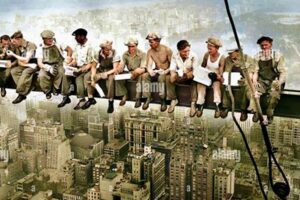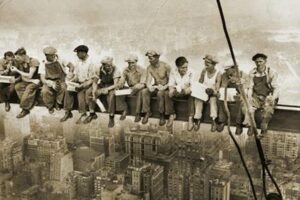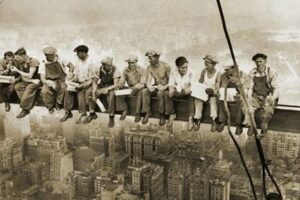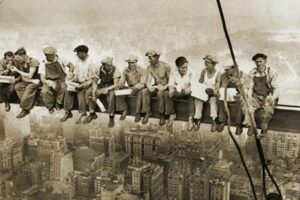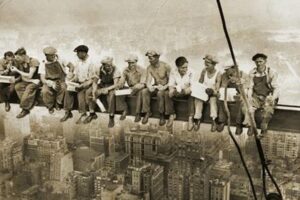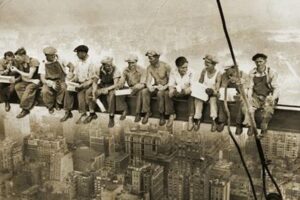A “lunch atop a skyscraper” experience refers to an iconic photograph taken during the construction of the Rockefeller Center in New York City in 1932. The black-and-white image depicts eleven construction workers sitting on a steel beam, casually eating their lunch hundreds of feet above the city streets.
The photograph has become a symbol of both the bravery and camaraderie of the construction workers who built some of the world’s tallest skyscrapers during the early 20th century. It has been widely reproduced and referenced in popular culture, and is considered one of the most famous photographs of all time.
The lunch atop a skyscraper experience has come to represent the challenges and triumphs of construction workers, as well as the growth and development of major cities. It is a reminder of the hard work and dedication of the people who build our world.
1. Daring
The “daring” of the workers in the “lunch atop a skyscraper” photograph is a key component of the image’s overall impact. The workers’ casual demeanor, perched hundreds of feet above the ground with no safety harnesses or other protective gear, belies the danger of their situation. This juxtaposition creates a sense of tension and excitement, and highlights the bravery of the workers.
In the early 20th century, when the photograph was taken, construction workers often worked without any safety precautions. This was due to a combination of factors, including the lack of regulations, the need to get the job done quickly, and the workers’ own sense of pride and bravado. As a result, construction work was one of the most dangerous occupations in the United States.
The workers in the “lunch atop a skyscraper” photograph are representative of the thousands of construction workers who risked their lives to build the skyscrapers that define the skylines of our cities. Their daring and bravery should never be forgotten.
Today, construction workers still face many hazards on the job. However, thanks to advances in safety regulations and equipment, the fatality rate for construction workers has declined significantly. Nevertheless, construction remains a dangerous occupation, and the workers who build our cities deserve our respect and admiration.
2. Camaraderie
The camaraderie among the workers in the “lunch atop a skyscraper” photograph is a key component of the image’s overall impact. The workers’ relaxed body language and smiles convey a sense of ease and comfort, despite the dangerous situation they are in. This camaraderie is a testament to the strong bonds that can form between people who work together in dangerous and challenging environments.
Camaraderie is essential for any team that works together, but it is especially important for construction workers. Construction work is often dangerous and unpredictable, and workers need to be able to rely on each other to get the job done safely and efficiently. Camaraderie helps to build trust and cooperation among workers, and it can also help to reduce stress and improve morale.
The camaraderie among the workers in the “lunch atop a skyscraper” photograph is a reminder of the importance of teamwork and cooperation. It is a testament to the human spirit and the ability of people to work together to achieve great things.
Here are some examples of how camaraderie can benefit a team:
- Increased productivity: Teams with strong camaraderie are more productive than teams with low camaraderie. This is because workers are more likely to cooperate and help each other out, which leads to a more efficient workflow.
- Improved safety: Teams with strong camaraderie are safer than teams with low camaraderie. This is because workers are more likely to look out for each other and follow safety procedures.
- Reduced stress: Teams with strong camaraderie have lower levels of stress than teams with low camaraderie. This is because workers are more likely to support each other and help each other through difficult times.
- Improved morale: Teams with strong camaraderie have higher morale than teams with low camaraderie. This is because workers are more likely to enjoy working together and feel like they are part of a team.
Camaraderie is an essential component of any successful team. It is a powerful force that can help teams achieve great things.
3. Bravado
The “bravado” of the workers in the “lunch atop a skyscraper” photograph is a key component of the image’s overall impact. The workers’ confident poses and direct gazes convey a sense of pride and accomplishment, despite the dangerous situation they are in. This bravado is a testament to the workers’ skill and courage, and it is a reminder of the human spirit’s ability to overcome adversity.
- Facet 1: Confidence
The workers in the photograph are clearly confident in their abilities. They are sitting on a steel beam, hundreds of feet above the ground, without any safety harnesses or other protective gear. Their confident poses convey a sense of ease and comfort, despite the danger they are in.
- Facet 2: Courage
The workers in the photograph are also clearly courageous. They are not only willing to work in a dangerous environment, but they are also willing to pose for a photograph that will capture their experience. Their courage is a testament to their strength of character and their commitment to their work.
- Facet 3: Pride
The workers in the photograph are clearly proud of their work. They are sitting on a steel beam, hundreds of feet above the ground, and they are taking a break to enjoy their lunch. Their pride is evident in their smiles and in the way they are looking directly at the camera.
- Facet 4: Accomplishment
The workers in the photograph have accomplished something great. They have helped to build one of the tallest buildings in the world, and they are taking a break to enjoy their lunch. Their accomplishment is a testament to their hard work and dedication.
The “bravado” of the workers in the “lunch atop a skyscraper” photograph is a reminder of the human spirit’s ability to overcome adversity. It is a testament to the workers’ skill, courage, pride, and accomplishment.
4. Challenge
The construction of skyscrapers is a challenging and dangerous endeavor. Workers must work at great heights, often in harsh weather conditions. They must also operate heavy machinery and work with dangerous materials. Despite these challenges, the workers in the “lunch atop a skyscraper” photograph are facing these challenges head-on, with determination and skill.
The “lunch atop a skyscraper” photograph is a powerful reminder of the challenges that construction workers face every day. It is also a testament to the workers’ skill, courage, and determination. These workers are an inspiration to us all, and they deserve our respect and admiration.
Cause and effect
The challenges that construction workers face can have a number of negative consequences. These consequences can include injuries, death, and property damage. However, the workers in the “lunch atop a skyscraper” photograph are taking steps to mitigate these risks. They are wearing safety gear, using proper equipment, and following safety procedures.By taking these steps, the workers are reducing the likelihood of accidents and injuries. They are also protecting themselves and others from property damage.
Importance of “Challenge: The construction of skyscrapers is a challenging and dangerous endeavor. The workers in the photograph are facing these challenges head-on, with determination and skill.” as a component of “lunch atop a skyscraper experience”
The “challenge” of constructing skyscrapers is an essential component of the “lunch atop a skyscraper” experience. Without the challenge, the photograph would not be as iconic or inspiring. The challenge is what makes the workers’ accomplishment so remarkable.The challenge also highlights the importance of teamwork and cooperation. The workers in the photograph are working together to overcome a common challenge. They are relying on each other to stay safe and to get the job done.
Real-life examples
There are many real-life examples of the challenges that construction workers face. In 2019, a construction worker in New York City was killed when he fell from a building. In 2018, a construction worker in San Francisco was injured when a crane collapsed. These are just two examples of the many accidents that can happen on construction sites.Despite these challenges, construction workers continue to build the skyscrapers that define our skylines. They do so with skill, courage, and determination.
Practical significance of this understanding
Understanding the challenges that construction workers face can help us to appreciate the importance of their work. It can also help us to make informed decisions about how to protect workers and prevent accidents.By understanding the challenges, we can also be more supportive of construction workers and their families. We can let them know that we appreciate their work and that we are thinking of them.
Conclusion
The “lunch atop a skyscraper” photograph is a powerful reminder of the challenges that construction workers face every day. It is also a testament to the workers’ skill, courage, and determination.
5. Triumph
The “triumph” of the workers in the “lunch atop a skyscraper” photograph is a key component of the image’s overall impact. The workers’ sense of accomplishment and pride is evident in their smiles and in the way they are looking directly at the camera. This triumph is a testament to the workers’ skill, courage, and determination.
The triumph of the workers is also a reminder of the importance of teamwork and cooperation. The construction of skyscrapers is a challenging and dangerous endeavor, and it requires the workers to work together as a team. The workers in the photograph are relying on each other to stay safe and to get the job done.
There are many real-life examples of the triumph of construction workers. In 2020, construction workers completed the construction of the One World Trade Center, the tallest building in the Western Hemisphere. This was a major triumph for the workers, and it is a testament to their skill, courage, and determination.
Understanding the triumph of construction workers can help us to appreciate the importance of their work. It can also help us to make informed decisions about how to protect workers and prevent accidents.
By understanding the triumph of construction workers, we can also be more supportive of construction workers and their families. We can let them know that we appreciate their work and that we are thinking of them.
6. Symbol
The “lunch atop a skyscraper” photograph has become a powerful symbol of the construction industry and the workers who build our cities. It is a reminder of the bravery, skill, and hard work that goes into building the world around us. The photograph has been reproduced and referenced in popular culture countless times, and it has come to represent the spirit of the American worker.
- Facet 1: Bravery
The workers in the photograph are sitting on a steel beam, hundreds of feet above the ground, with no safety harnesses or other protective gear. Their bravery is evident in their relaxed demeanor and confident smiles.
- Facet 2: Skill
The workers in the photograph are highly skilled. They are able to work at great heights and operate heavy machinery with precision. Their skill is essential for the safe and efficient construction of skyscrapers.
- Facet 3: Hard work
The construction of skyscrapers is a challenging and demanding task. The workers in the photograph are working hard to complete the job on time and within budget. Their hard work is evident in their tired faces and dirty clothes.
- Facet 4: Legacy
The “lunch atop a skyscraper” photograph is a reminder of the legacy of the American worker. The workers in the photograph are part of a long tradition of skilled and hardworking men and women who have built our country’s infrastructure.
The “lunch atop a skyscraper” photograph is a powerful reminder of the importance of construction workers and the role they play in our society. It is a reminder of the bravery, skill, and hard work that goes into building the world around us.
7. Legacy
The “lunch atop a skyscraper” photograph is a powerful reminder of the challenges that Americans faced during the Great Depression. The workers in the photograph are sitting on a steel beam, hundreds of feet above the ground, with no safety harnesses or other protective gear. Their bravery and determination are a testament to the indomitable spirit of the American people.
- Facet 1: Resilience
The workers in the photograph are resilient. They are facing the challenges of the Great Depression head-on, and they are determined to overcome them. Their resilience is a reminder that the American people are always able to overcome adversity.
- Facet 2: Hope
The workers in the photograph are hopeful. They believe that the future will be better, and they are working hard to make that future a reality. Their hope is a reminder that the American people always have hope for a better tomorrow.
- Facet 3: Unity
The workers in the photograph are united. They are working together to overcome the challenges of the Great Depression, and they are supporting each other through thick and thin. Their unity is a reminder that the American people are always stronger when they work together.
- Facet 4: Strength
The workers in the photograph are strong. They are physically strong, but they are also strong in spirit. Their strength is a reminder that the American people are always strong, even in the face of adversity.
The “lunch atop a skyscraper” photograph is a reminder of the challenges that Americans have faced throughout our history, and it is a testament to the indomitable spirit of the American people. We are a resilient, hopeful, united, and strong people, and we will always overcome any challenges that we face.
FAQs
The iconic “Lunch atop a Skyscraper” photograph, capturing construction workers casually eating lunch on a steel beam hundreds of feet above the city streets, has sparked both awe and curiosity since its inception. Here are some frequently asked questions and their respective answers, shedding light on various aspects of this extraordinary moment in history:
Question 1: What is the historical context behind the “Lunch atop a Skyscraper” photograph?
The image was captured during the construction of the Rockefeller Center in New York City in 1932, amidst the depths of the Great Depression. It symbolized the resilience and determination of American workers during an economically challenging period.
Question 2: Who were the individuals depicted in the photograph?
The eleven construction workers in the photo remain unidentified, as they were not directly named in any accompanying documentation. However, they represent the countless brave and hardworking individuals who contributed to the construction of New York City’s skyline.
Question 3: Were any safety precautions taken during the lunch break depicted in the photograph?
Notably, the construction workers in the photograph are not wearing any visible safety gear, such as harnesses or hard hats. This reflects the lax safety standards prevalent in the construction industry at that time.
Question 4: What is the significance of the photograph beyond its historical value?
The “Lunch atop a Skyscraper” photograph has become an enduring symbol of American ingenuity, courage, and the spirit of collaboration. It continues to inspire and motivate individuals and organizations facing challenges.
Question 5: Are there any known controversies or debates surrounding the photograph?
Over the years, there have been discussions regarding the authenticity of the photograph, with some suggesting it was staged or manipulated. However, the prevailing view among experts is that the image is genuine and accurately captures a moment in time.
Question 6: How can we preserve the legacy of the “Lunch atop a Skyscraper” experience?
Preserving the legacy of this iconic moment involves cherishing its historical significance, acknowledging the contributions of the construction workers, and promoting safety practices in modern construction projects. Additionally, showcasing the photograph in museums, exhibitions, and educational materials helps ensure its continued relevance and inspiration.
In conclusion, the “Lunch atop a Skyscraper” experience serves as a poignant reminder of the human spirit’s ability to overcome adversity and achieve remarkable feats. It is a timeless image that continues to captivate and inspire generations.
Transition to the next article section: Exploring the broader implications and contemporary relevance of the “Lunch atop a Skyscraper” photograph.
Tips Inspired by the “Lunch atop a Skyscraper” Experience
The iconic “Lunch atop a Skyscraper” photograph offers valuable lessons and principles that can be applied to various aspects of life. Here are five tips inspired by this extraordinary moment in history:
Tip 1: Embrace Courage and Calculated Risks
The construction workers in the photograph exemplify courage and the willingness to take calculated risks. In our endeavors, we should strive to step outside of our comfort zones, assess risks thoughtfully, and embrace challenges with determination.
Tip 2: Cultivate Teamwork and Collaboration
The workers’ camaraderie and teamwork were crucial for their success. In our own pursuits, fostering strong relationships with colleagues, teammates, or collaborators can enhance productivity and overall outcomes.
Tip 3: Prioritize Safety and Well-being
While the photograph captures a moment of casual relaxation, it also serves as a reminder of the importance of safety in any endeavor. We should always prioritize our well-being and take necessary precautions to minimize risks.
Tip 4: Find Inspiration in Adversity
The construction of the Rockefeller Center took place during the Great Depression. The workers’ resilience and determination amidst challenging times demonstrate that we can find inspiration and strength even in the face of adversity.
Tip 5: Celebrate Achievements and Milestones
The workers’ lunch break was not only a moment of respite but also a celebration of their progress. It is important to acknowledge and celebrate our achievements, big and small, as they serve as motivasi and recognition of our efforts.
Summary
The “Lunch atop a Skyscraper” experience offers timeless lessons in courage, teamwork, safety, resilience, and celebration. By incorporating these principles into our own lives, we can strive for greater heights and achieve our goals with purpose and fulfillment.
Transition
The following section will delve into the broader implications and contemporary relevance of the “Lunch atop a Skyscraper” photograph in our modern world.
Conclusion
The “Lunch atop a Skyscraper” photograph has captured the imagination of generations, transcending its historical context to become a timeless symbol of human endeavor and resilience. This iconic image serves as a reminder of the courage, teamwork, and determination required to achieve remarkable feats, even in the face of adversity.
The broader implications of this experience resonate in our contemporary world. It challenges us to embrace challenges, prioritize safety, cultivate strong relationships, and celebrate our achievements. By embodying the principles exemplified by the construction workers in the photograph, we can strive for progress, innovation, and the betterment of our communities.


